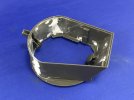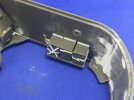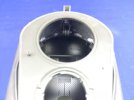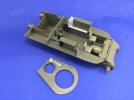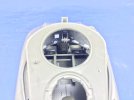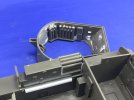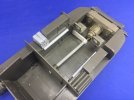Now with that here, I think it’s time for a bit more history of the kind that several of you appear to enjoy reading

Like others, the US Army recognised the need for vehicles to clear mines quickly during an attack. Where the British mainly tried rollers, ploughs, explosive line charges and flails, then mostly settled on the latter, the Americans mainly worked on rollers, in addition to keeping an eye on British developments and also trying all kinds of oddball things, including an adaptation of naval Hedgehog anti-submarine mortars and even a bunch of heavy-duty pistons that would pound the ground in front of the tank. Most successful of all these, though, seemed to be very heavy rollers. The first serious attempt was the Mine Exploder T1:
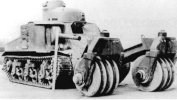
This consisted of rollers made up of several large, heavy steel discs. Two rollers were mounted on the front of the M3 medium tank, and a third was towed behind it. It was soon improved by moving the third roller to the front, probably so that there was no risk of any mines ending up under the tank, and so became the T1E1.* However, that put a lot of weight on the front, so it was decided to use it with the M32 tank recovery vehicle instead, because it was envisioned that it could use its crane to take some of the weight, and the crane also came in handy for fitting and removing the rollers from the vehicle. The combination looked like this:
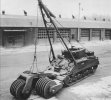
This had rollers made up of discs 122 cm in diameter, 5 cm thick and weighing some 580 kg each, resulting in a complete roller that weighed around 16 tonnes; it could clear a path about 3 metres wide. The combination appeared to work well enough, so 75 of them were produced in April of 1944 and most of them shipped to Europe. Units to use them were only formed in September that year, though, when 738 and 739 Tank Battalions (Special) were converted from
Shop Tractors to Mine Exploder tanks. Each was to have 18 T1E1s, 24 T1E3s, 12 tank dozers, and 18 Shermans with 76 mm guns, but in practice were also assigned some British-supplied Sherman Crabs, and even a few Sherman DD (amphibious) tanks for the crossing of the Rhine in 1945.
The T1E2 had larger but thinner rollers than the T1E1, was also used on the M32, but not produced beyond prototypes. The T1E3 did go into production; it had even larger rollers than the T1E1, and was mounted on a regular Sherman tank. To improve mobility, the rollers were powered by means of a chain driven by the tank’s drive sprocket:
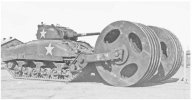
Under actual battlefield conditions, though, all of these tanks were very slow and bogged down extremely quickly in soft ground, like here:
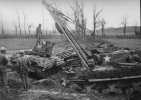
On the left is a T1E3 that was clearing mines on a road on 19 December 1944; when some mines detonated, they blew out part of the road and caused the tank to slide into the ditch along the side of the road and it got very stuck. You can see the rollers have been detached from the tank to aid in its recovery, for which two M32B1s are used. Both of those M32B1s have a large horizontal bar with big eyes on the hull front, indicating that they are actually also mine exploders: that bar is where the T1E1 equipment attaches.
Oh, and since we’re discussing US Army experimental mine exploders here, I can’t really
not mention this one:
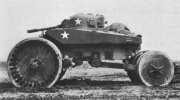
This is the mine exploder T10, which was an M4A2 Sherman tank with the front corners of the hull cut away so that 244 cm diameter rollers could be fitted, driven from the normal transmission, and a 183 cm one at the rear. This was not considered a success, oddly enough
 * And here’s an aside on US Army equipment designations thrown in for free
* And here’s an aside on US Army equipment designations thrown in for free  Since the late 1920s, equipment was principally designated by a short description of its function, followed by an M-number that started at 1 for every class of equipment. Thus, there was an M1 rifle, an M1 carbine, an M1 helmet, an M1 combat car (read: “light tank for the Cavalry”), and so on. There never really was an M1 medium tank, but there were M2, M3 and M4 medium tanks. Variants were indicated with an A after the number, followed by a sequential number to indicate the variant: M1 is the basic version of the thing, M1A1 is the first variant, M1A2 is the second, etc. (In the early 1940s, it was realised that this was confusing, so sequential numbering was mostly dropped. This is why there are light tanks M3 and M5, but not a light tank M4 — that was to have been the designation, but expected confusion with the medium tank M4 resulted in it being called the M5 instead.)
Since the late 1920s, equipment was principally designated by a short description of its function, followed by an M-number that started at 1 for every class of equipment. Thus, there was an M1 rifle, an M1 carbine, an M1 helmet, an M1 combat car (read: “light tank for the Cavalry”), and so on. There never really was an M1 medium tank, but there were M2, M3 and M4 medium tanks. Variants were indicated with an A after the number, followed by a sequential number to indicate the variant: M1 is the basic version of the thing, M1A1 is the first variant, M1A2 is the second, etc. (In the early 1940s, it was realised that this was confusing, so sequential numbering was mostly dropped. This is why there are light tanks M3 and M5, but not a light tank M4 — that was to have been the designation, but expected confusion with the medium tank M4 resulted in it being called the M5 instead.)
When there was some kind of substitution made for manufacturing purposes, but which made no functional difference to the item’s operation, a B-number was assigned. Thus, the M1 is a thing, the M1B1 is the same thing but with — for example — a part that was made in aluminium now being made in steel, or wood substituted for plastic, or something like that. This is why the model I’m building is an M32B1: the M32 uses the hull of the M4 medium tank, while the M32B1 is functionally identical but uses the hull of the M4A1.**
Now, T-numbers indicate prototypes; once it was standardised for service, it got an M-number instead, and often not the same as the T-number. For example, the Tank Recovery Vehicle T5 became the Tank Recovery Vehicle M32 upon standardisation. Similarly, variants or alternate designs of prototype items get an E-number instead of an A-number: the mine exploder T1 was the first roller device, the T1E1 was the second, T1E2 third, etc.
** If you’re following along, you may now realise that the Sherman’s designations break the rules. The principal difference between the M4 and M4A1 is how the hull is constructed, while that between M4, M4A2, M4A3, M4A4 and M4A6 is the engine. Neither of these affects the tank’s basic functionality, so they should have been M4, M4B1, M4B2, etc. Oddly, this logic was followed for the M32 TRV.


